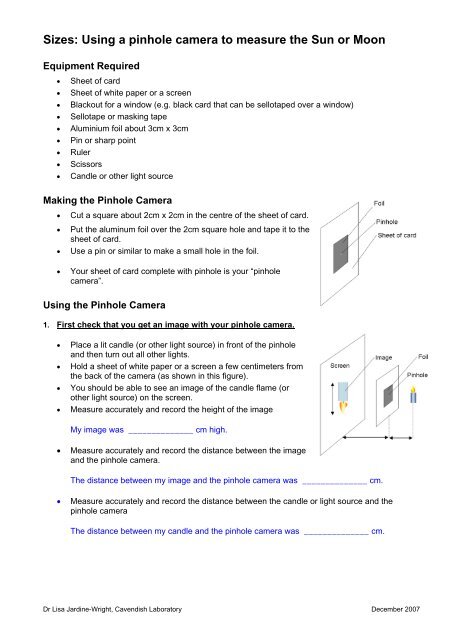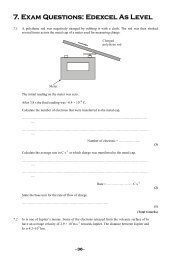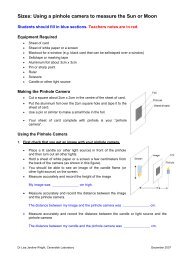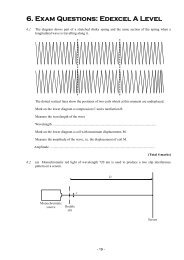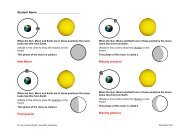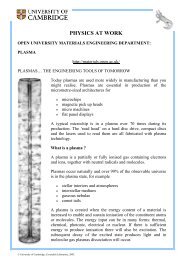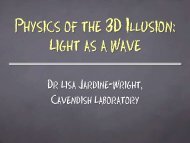Student worksheet
Student worksheet
Student worksheet
Create successful ePaper yourself
Turn your PDF publications into a flip-book with our unique Google optimized e-Paper software.
Sizes: Using a pinhole camera to measure the Sun or Moon<br />
Equipment Required<br />
• Sheet of card<br />
• Sheet of white paper or a screen<br />
• Blackout for a window (e.g. black card that can be sellotaped over a window)<br />
• Sellotape or masking tape<br />
• Aluminium foil about 3cm x 3cm<br />
• Pin or sharp point<br />
• Ruler<br />
• Scissors<br />
• Candle or other light source<br />
Making the Pinhole Camera<br />
• Cut a square about 2cm x 2cm in the centre of the sheet of card.<br />
• Put the aluminum foil over the 2cm square hole and tape it to the<br />
sheet of card.<br />
• Use a pin or similar to make a small hole in the foil.<br />
• Your sheet of card complete with pinhole is your “pinhole<br />
camera”.<br />
Using the Pinhole Camera<br />
1. First check that you get an image with your pinhole camera.<br />
• Place a lit candle (or other light source) in front of the pinhole<br />
and then turn out all other lights.<br />
• Hold a sheet of white paper or a screen a few centimeters from<br />
the back of the camera (as shown in this figure).<br />
• You should be able to see an image of the candle flame (or<br />
other light source) on the screen.<br />
• Measure accurately and record the height of the image<br />
My image was ______________ cm high.<br />
• Measure accurately and record the distance between the image<br />
and the pinhole camera.<br />
The distance between my image and the pinhole camera was ______________ cm.<br />
• Measure accurately and record the distance between the candle or light source and the<br />
pinhole camera<br />
The distance between my candle and the pinhole camera was ______________ cm.<br />
Dr Lisa Jardine-Wright, Cavendish Laboratory December 2007
Things to find out<br />
• What happens to the size of the image as you move the sheet of paper or screen further<br />
away from the pinhole, but keep the candle in the same place?<br />
________________________________________________________________________<br />
________________________________________________________________________<br />
• Try drawing a graph of image height (vertical axis) against the distance of the paper or<br />
screen from the pinhole camera (horizontal axis).<br />
• Look at your graph – what do you think it tells you?<br />
• For each pair of measurements, calculate the result when you divide the height of the<br />
image by the distance between the camera and the screen or paper.<br />
• Multiply the result of the division calculations by the distance between the candle and the<br />
pinhole camera.<br />
Height of image cm<br />
× ·distance between the candle and the pinhole cm<br />
Distance to screen from pinhole cm<br />
= _________________________ cm<br />
= Height of the candle flame or light source<br />
• Measure the height of your candle flame or light source.<br />
My light source is _____________________cm high<br />
How similar are the your two values for the height of the light source _________________<br />
2. Finding the diameter of the Sun or Moon.<br />
It is very important that no one looks directly at the sun, as this will damage the retina in<br />
the eye. The pinhole camera is a safe way to observe the sun, since you only need to<br />
look at the image on the screen, not directly at it.<br />
• Black out a window that faces<br />
the Sun or Moon, and cut a<br />
square about 2cm x 2cm in the<br />
centre of the blackout material.<br />
• Put the foil over the square<br />
hole and tape it to the blackout<br />
material.<br />
• Use a pin or similar to make a<br />
small hole in the foil.<br />
• Turn out all the lights in the<br />
room.<br />
• Hold a sheet of white paper or<br />
a screen as far from the<br />
pinhole as possible.<br />
• You should now be able to see<br />
an image of the Sun or Moon on the paper or screen – if it isn’t clear enough, try blacking<br />
out more windows to reduce the light in the room or experiment with the size of your<br />
pinhole.<br />
Dr Lisa Jardine-Wright, Cavendish Laboratory December 2007
• Measure accurately and record the distance between the pinhole and the white paper or<br />
screen.<br />
The distance between my image and the pinhole camera was ______________ cm.<br />
• Measure accurately and record the diameter of your images of the Sun or Moon (using the<br />
same units).<br />
The diameter of my Sun or Moon image is ______________ cm.<br />
• Now we will calculate the real diameter of the Sun or Moon from your measurements.<br />
Calculation<br />
• The diameters of the moon and the cut-out semi-circle are in the same proportion as the<br />
distances between your eye and the moon and between your eye and the window.<br />
Diameter<br />
Distance from Earth of Sun or Moon × Diameter<br />
of Sun or Moon =<br />
Distance to Screen from Pinhole<br />
of Image<br />
• The distance of the Earth from the Sun is 149,600,000km<br />
• The distance of the Earth from the Moon is 384,400 km<br />
• You will need to make sure that you change all your distance measurements to the same<br />
units, e.g. metres.<br />
o Remember there are 100cm in 1m and 1000m in 1km.<br />
• Fill in the blanks in the boxes below<br />
Diameter<br />
of<br />
________ in km =<br />
km<br />
×<br />
cm<br />
cm<br />
Diameter of ________ in km =<br />
km<br />
Things to think about<br />
• How many times bigger is the Sun than the Moon?<br />
________________________________________________________________________<br />
________________________________________________________________________<br />
• Why do you think that they appear to be about the same size to us?<br />
________________________________________________________________________<br />
________________________________________________________________________<br />
Dr Lisa Jardine-Wright, Cavendish Laboratory December 2007


